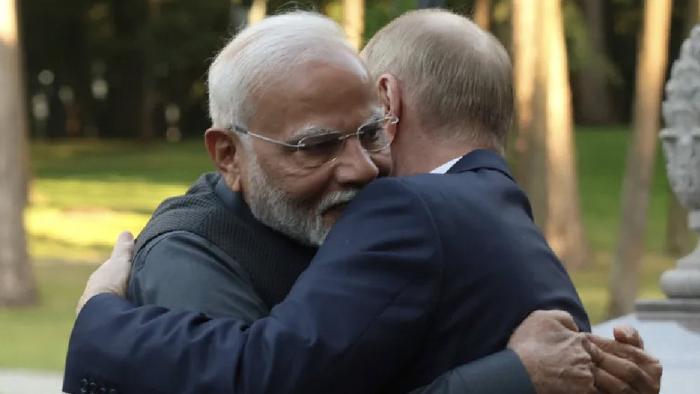
Two days ago, Trump issued a “final ultimatum” to Russia. His tone was firm: If Russia and Ukraine fail to reach a peace agreement within 50 days, then sanctions will be imposed, with a 100% tariff on Russia!
Russia shrugged: After the war began, over 6,500 sanctions have been imposed, and there’s hardly any business with the United States, just $3.5 billion a year, which is negligible.
The White House then proceeded to play its hand: For those countries that purchase Russian oil, a “secondary tariff” will be imposed, with a rate of 100%!
As the U.S. Secretary of Commerce put it, the White House is aiming for “secondary sanctions,” imposing tariffs of up to 500% on countries or entities trading with Russia.
What are “secondary tariffs” and “secondary sanctions”?
Zhou Min, a researcher at the Institute of International Trade and Economic Cooperation at the Ministry of Commerce, explained that what we call secondary sanctions refers to the sanctions imposed by the United States based on domestic laws against countries or entities with economic and trade relations with its primary sanction targets, serving as a means of the U.S.’s extensive jurisdiction.
A similar practice has been used against “terrorist states” identified by the U.S., prohibiting third countries from doing business with these states and refusing to use the dollar for transactions, punishing those who violate this rule. Cases such as Meng Wanzhou and ZTE are all related to these types of sanctions.
After Trump returned to the White House, he introduced another “secondary tariff.” In March, the White House announced that anyone buying oil from Venezuela or Iran would face increased taxes; now, they’re targeting Russia again.
Implicitly, you Russians are not sensitive to tariffs, but your oil clients are!
Currently, Russia’s main exporters are India and China. Who will be affected?
Let’s start with China. In 2024, China imported more than 100 million tons of crude oil from Russia, accounting for nearly two-tenths of our total imports. Other major import destinations include Saudi Arabia, Iraq, Brazil, etc., which are very diverse.
There’s also the role of a non-dollar settlement system as a safe haven.
Zhou Min introduced that due to the frequent and unpredictable U.S. sanctions, which severely weakened the international credit of the dollar and also diminished the willingness of all parties to use the dollar, in the current and future phase, global trade, especially trade with Russia, will adopt more diverse settlement methods, to a certain extent, can support the survival of Russian exports.
However, India might be significantly affected.
After the outbreak of the Russia-Ukraine conflict, India bought Russian oil at low prices and refined it domestically before selling it to Europe and America, earning a significant amount. India’s energy heavily relies on imports, with Russia being the top supplier; for a large part of India’s weapon systems, Russia is also the supplier. Therefore, the U.S. has been accusing India of “evading sanctions” for helping Russia. If secondary tariffs are indeed implemented, imposing 100% or 500% tariffs on India, the Modi government might find it very difficult.
After all, Russian oil cannot be cut off completely; if it were to switch to purchasing crude oil from the Middle East or the United States, the price would be much higher than just a bit; the U.S. is not willing to fight, and even if the dollar was to be blocked by some kind of payment system, Indian businesses would have to shut down.
Both sides are big brothers, and neither side is easy to deal with. What should be done? The outside world is eagerly waiting to see what India will do in response.
Zhou Min believes that as a major global oil supplier, if supply is disrupted, the prices of fossil energy and other primary global energy sources will significantly rise. Investors are still observing the prospects of Russian oil exports.
On another note, why did the U.S. suddenly implement secondary sanctions and tariffs?
Professor Li Haidong from the Institute of International Relations at the Foreign Affairs University analyzed that Trump had long failed to mediate the conflict effectively and lost patience with Russia. He wanted to pressure Russia to end the conflict through sanctions, responding to the mainstream sentiment within the U.S. of “reducing overseas military intervention.” At the same time, using pro-mediation actions to present himself as a “mediator” not only laid the groundwork for subsequent blame-shifting but also prepared for votes.
On the other hand, this is also a signature transactional and coercive foreign policy of the Trump administration.
Previously, under immense pressure, Ukraine was forced to sign a mineral agreement. Now, by imposing tariffs on Russia, the same tactics are being used to “threaten for dialogue,” hoping to coax Russia into sitting down.
Interestingly, the United States has also made a high-profile announcement this time, providing Ukraine with Patriot missiles and specifically stated: NATO is footing the bill—it’s shouting for peace while handing out the swords. By not having to spend its own money, it can exert pressure on its adversary and send the message that whoever doesn’t align will be penalized. This strategy effectively multiplies benefits, isn’t it wonderful?
The question is, can secondary sanctions really work?
From the perspective of oil and energy supply, the US action is difficult to hurt Russia and does not cut off other countries’ trade with Russia in energy, but could instead tear apart the global supply chain. As an important energy source currently, the US itself would be affected.
As for the effectiveness of tariffs and sanctions?
Previously, when the US heavily implemented reciprocal tariffs, no one compromised, so there was nothing further to discuss. Given the White House’s changeable and unpredictable policies, a rational choice is to wait and see first, then diversify our investments across energy, security, and supply chains.
In conclusion, as always, the world has changed; relying solely on strong pressure tactics is no longer effective.